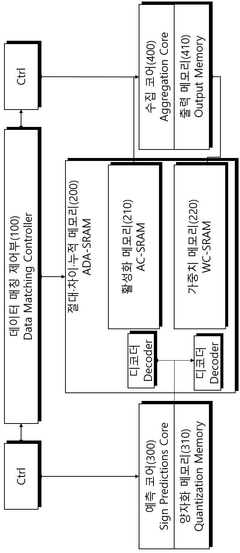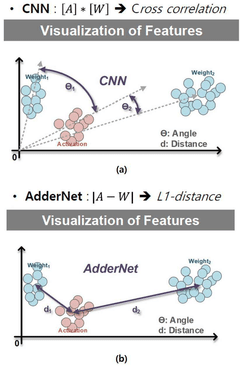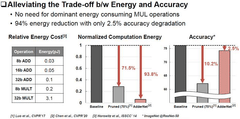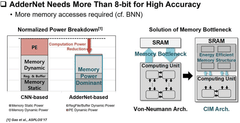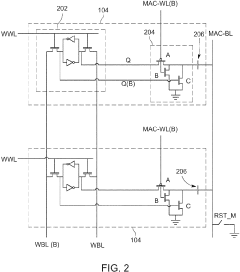Energy Harvesting Compatibility Of In-Memory Computing Accelerators
SEP 2, 202510 MIN READ
Generate Your Research Report Instantly with AI Agent
Patsnap Eureka helps you evaluate technical feasibility & market potential.
Energy Harvesting and IMC Technology Background
Energy harvesting technologies have evolved significantly over the past decades, transforming from simple mechanical systems to sophisticated micro-scale energy conversion mechanisms. These technologies capture ambient energy from various sources including solar, thermal, kinetic, and electromagnetic radiation, converting it into usable electrical power. The fundamental principle behind energy harvesting involves transduction mechanisms that convert one form of energy into electrical energy through processes such as the photovoltaic effect, piezoelectric effect, or thermoelectric conversion.
In parallel, In-Memory Computing (IMC) has emerged as a revolutionary computing paradigm designed to address the von Neumann bottleneck—the performance limitation caused by the separation between processing and memory units. Traditional computing architectures suffer from significant energy consumption and latency issues when transferring data between memory and processing units. IMC mitigates these challenges by performing computational operations directly within memory arrays, dramatically reducing data movement and associated energy costs.
The convergence of these two technologies presents a compelling opportunity for next-generation computing systems. Energy harvesting can potentially provide sustainable power sources for IMC accelerators, particularly in edge computing applications where power availability is limited or intermittent. This synergy is especially relevant as the Internet of Things (IoT) ecosystem continues to expand, demanding more energy-efficient computing solutions at the edge.
Historical development of IMC technologies shows a progression from conceptual designs to practical implementations using various memory technologies including SRAM, DRAM, flash memory, and emerging non-volatile memories such as resistive RAM (RRAM), phase-change memory (PCM), and magnetic RAM (MRAM). Each memory technology offers different trade-offs in terms of speed, energy efficiency, density, and compatibility with computational operations.
Energy harvesting technologies have similarly progressed through multiple generations, with improvements in efficiency, form factor, and integration capabilities. Modern micro-scale energy harvesters can now generate power in the microwatt to milliwatt range, potentially sufficient for low-power IMC operations in specific applications.
The technical challenge lies in matching the power generation profiles of energy harvesters—often variable and unpredictable—with the power consumption requirements of IMC accelerators. This compatibility challenge encompasses issues of power stability, energy storage buffering, voltage regulation, and dynamic power management to ensure reliable operation under fluctuating energy availability conditions.
Recent research has begun exploring architectural innovations that can adapt IMC operations to variable power conditions, including techniques for graceful performance scaling, task prioritization, and computational approximation under energy constraints. These developments point toward a future where computing systems might dynamically adjust their computational capabilities based on available harvested energy.
In parallel, In-Memory Computing (IMC) has emerged as a revolutionary computing paradigm designed to address the von Neumann bottleneck—the performance limitation caused by the separation between processing and memory units. Traditional computing architectures suffer from significant energy consumption and latency issues when transferring data between memory and processing units. IMC mitigates these challenges by performing computational operations directly within memory arrays, dramatically reducing data movement and associated energy costs.
The convergence of these two technologies presents a compelling opportunity for next-generation computing systems. Energy harvesting can potentially provide sustainable power sources for IMC accelerators, particularly in edge computing applications where power availability is limited or intermittent. This synergy is especially relevant as the Internet of Things (IoT) ecosystem continues to expand, demanding more energy-efficient computing solutions at the edge.
Historical development of IMC technologies shows a progression from conceptual designs to practical implementations using various memory technologies including SRAM, DRAM, flash memory, and emerging non-volatile memories such as resistive RAM (RRAM), phase-change memory (PCM), and magnetic RAM (MRAM). Each memory technology offers different trade-offs in terms of speed, energy efficiency, density, and compatibility with computational operations.
Energy harvesting technologies have similarly progressed through multiple generations, with improvements in efficiency, form factor, and integration capabilities. Modern micro-scale energy harvesters can now generate power in the microwatt to milliwatt range, potentially sufficient for low-power IMC operations in specific applications.
The technical challenge lies in matching the power generation profiles of energy harvesters—often variable and unpredictable—with the power consumption requirements of IMC accelerators. This compatibility challenge encompasses issues of power stability, energy storage buffering, voltage regulation, and dynamic power management to ensure reliable operation under fluctuating energy availability conditions.
Recent research has begun exploring architectural innovations that can adapt IMC operations to variable power conditions, including techniques for graceful performance scaling, task prioritization, and computational approximation under energy constraints. These developments point toward a future where computing systems might dynamically adjust their computational capabilities based on available harvested energy.
Market Analysis for Energy-Efficient Computing Solutions
The energy-efficient computing solutions market is experiencing unprecedented growth, driven by the increasing demand for sustainable technologies across various sectors. Current market valuations indicate that energy-efficient computing solutions reached approximately $25 billion in 2022, with projections suggesting a compound annual growth rate of 12-15% through 2028. This growth trajectory is particularly significant for in-memory computing accelerators with energy harvesting capabilities, which represent an emerging segment with substantial potential.
Key market drivers include the exponential increase in data processing requirements, particularly in edge computing environments where power constraints are critical. Organizations across industries are prioritizing solutions that can reduce energy consumption while maintaining or improving computational performance. According to recent industry surveys, 78% of enterprise IT decision-makers now consider energy efficiency a top-three factor in computing infrastructure investments, compared to just 45% five years ago.
The market segmentation reveals distinct customer profiles with varying needs. Hyperscale data centers represent the largest market segment by volume, seeking solutions that can significantly reduce their massive energy footprints. Edge computing applications form the fastest-growing segment, with 32% year-over-year growth, driven by IoT expansion and the need for power-autonomous computing nodes. Mobile and embedded systems manufacturers constitute another significant segment, particularly interested in energy harvesting capabilities to extend device operational lifetimes.
Regional analysis shows North America leading with approximately 42% market share, followed by Asia-Pacific at 35%, which is growing at the fastest rate due to rapid digital infrastructure expansion in China, South Korea, and Taiwan. Europe accounts for 20% of the market, with particularly strong demand in countries with aggressive carbon reduction targets and high energy costs.
Competitive landscape assessment reveals traditional semiconductor giants investing heavily in energy-efficient architectures, while specialized startups are pioneering novel approaches to in-memory computing with energy harvesting integration. Venture capital funding in this specific technology area has increased by 85% over the past three years, indicating strong investor confidence in market potential.
Customer adoption patterns demonstrate a clear shift from proof-of-concept deployments to production implementations, with early adopters reporting energy savings of 40-60% compared to conventional computing architectures. This translates to significant operational cost reductions, with average payback periods of 18-24 months for enterprise deployments, creating a compelling value proposition despite higher initial investment requirements.
Key market drivers include the exponential increase in data processing requirements, particularly in edge computing environments where power constraints are critical. Organizations across industries are prioritizing solutions that can reduce energy consumption while maintaining or improving computational performance. According to recent industry surveys, 78% of enterprise IT decision-makers now consider energy efficiency a top-three factor in computing infrastructure investments, compared to just 45% five years ago.
The market segmentation reveals distinct customer profiles with varying needs. Hyperscale data centers represent the largest market segment by volume, seeking solutions that can significantly reduce their massive energy footprints. Edge computing applications form the fastest-growing segment, with 32% year-over-year growth, driven by IoT expansion and the need for power-autonomous computing nodes. Mobile and embedded systems manufacturers constitute another significant segment, particularly interested in energy harvesting capabilities to extend device operational lifetimes.
Regional analysis shows North America leading with approximately 42% market share, followed by Asia-Pacific at 35%, which is growing at the fastest rate due to rapid digital infrastructure expansion in China, South Korea, and Taiwan. Europe accounts for 20% of the market, with particularly strong demand in countries with aggressive carbon reduction targets and high energy costs.
Competitive landscape assessment reveals traditional semiconductor giants investing heavily in energy-efficient architectures, while specialized startups are pioneering novel approaches to in-memory computing with energy harvesting integration. Venture capital funding in this specific technology area has increased by 85% over the past three years, indicating strong investor confidence in market potential.
Customer adoption patterns demonstrate a clear shift from proof-of-concept deployments to production implementations, with early adopters reporting energy savings of 40-60% compared to conventional computing architectures. This translates to significant operational cost reductions, with average payback periods of 18-24 months for enterprise deployments, creating a compelling value proposition despite higher initial investment requirements.
Current Challenges in Energy Harvesting for IMC
Despite the promising potential of In-Memory Computing (IMC) accelerators to revolutionize energy-efficient computing, their integration with energy harvesting systems presents significant challenges. The fundamental issue lies in the mismatch between the power requirements of IMC devices and the unstable, intermittent nature of harvested energy. Most current IMC architectures are designed with the assumption of continuous, stable power supply, making them incompatible with the fluctuating power profiles typical of energy harvesting sources such as solar, thermal, or vibrational energy.
The voltage compatibility presents a major hurdle. Energy harvesting systems typically generate low voltages (often below 1V), while many IMC accelerators, particularly those based on emerging non-volatile memory technologies like RRAM or PCM, require higher operating voltages for reliable operation. This voltage gap necessitates power conditioning circuits that introduce additional energy overhead, reducing the overall efficiency gains of the combined system.
Power management becomes exceptionally complex when dealing with IMC accelerators under harvested energy conditions. The computational accuracy and reliability of IMC operations are highly dependent on stable power delivery. Voltage fluctuations can lead to computational errors, particularly in analog IMC designs where computational precision directly correlates with power stability. Current power management techniques for IMC are not optimized for the unpredictable nature of harvested energy.
Data retention during power failures represents another critical challenge. When energy availability drops below operational thresholds, IMC accelerators face the risk of data loss or computational state corruption. While some non-volatile memory-based IMC solutions inherently offer data persistence, the control logic and peripheral circuits still require mechanisms to safely handle power interruptions, which are not fully developed in current architectures.
The thermal management of IMC accelerators under energy harvesting conditions also presents unique challenges. The intermittent operation pattern can lead to frequent thermal cycling, potentially accelerating wear-out mechanisms in the memory devices. Additionally, many energy harvesting scenarios involve deployment in harsh environmental conditions, where temperature variations further complicate the reliable operation of IMC accelerators.
Scaling challenges further compound these issues. As IMC accelerators move toward higher densities and more complex architectures to support advanced AI workloads, their power requirements increase, widening the gap between energy harvesting capabilities and computational demands. Current energy harvesting technologies struggle to scale proportionally with the growing power needs of advanced IMC accelerators.
The lack of standardized benchmarking methodologies for evaluating IMC performance under energy harvesting conditions hinders progress in this field. Researchers currently use disparate metrics and test conditions, making it difficult to compare solutions and establish best practices for energy-harvested IMC system design.
The voltage compatibility presents a major hurdle. Energy harvesting systems typically generate low voltages (often below 1V), while many IMC accelerators, particularly those based on emerging non-volatile memory technologies like RRAM or PCM, require higher operating voltages for reliable operation. This voltage gap necessitates power conditioning circuits that introduce additional energy overhead, reducing the overall efficiency gains of the combined system.
Power management becomes exceptionally complex when dealing with IMC accelerators under harvested energy conditions. The computational accuracy and reliability of IMC operations are highly dependent on stable power delivery. Voltage fluctuations can lead to computational errors, particularly in analog IMC designs where computational precision directly correlates with power stability. Current power management techniques for IMC are not optimized for the unpredictable nature of harvested energy.
Data retention during power failures represents another critical challenge. When energy availability drops below operational thresholds, IMC accelerators face the risk of data loss or computational state corruption. While some non-volatile memory-based IMC solutions inherently offer data persistence, the control logic and peripheral circuits still require mechanisms to safely handle power interruptions, which are not fully developed in current architectures.
The thermal management of IMC accelerators under energy harvesting conditions also presents unique challenges. The intermittent operation pattern can lead to frequent thermal cycling, potentially accelerating wear-out mechanisms in the memory devices. Additionally, many energy harvesting scenarios involve deployment in harsh environmental conditions, where temperature variations further complicate the reliable operation of IMC accelerators.
Scaling challenges further compound these issues. As IMC accelerators move toward higher densities and more complex architectures to support advanced AI workloads, their power requirements increase, widening the gap between energy harvesting capabilities and computational demands. Current energy harvesting technologies struggle to scale proportionally with the growing power needs of advanced IMC accelerators.
The lack of standardized benchmarking methodologies for evaluating IMC performance under energy harvesting conditions hinders progress in this field. Researchers currently use disparate metrics and test conditions, making it difficult to compare solutions and establish best practices for energy-harvested IMC system design.
Existing Energy Harvesting Solutions for IMC Accelerators
01 Energy harvesting integration with in-memory computing
Integration of energy harvesting technologies with in-memory computing accelerators enables self-powered operation of computing systems. These systems can capture ambient energy from the environment (such as solar, thermal, or vibrational energy) and convert it into electrical power to support in-memory computing operations, reducing dependence on external power sources and enhancing energy efficiency for edge computing applications.- Energy harvesting integration with in-memory computing: Energy harvesting technologies can be integrated with in-memory computing accelerators to create self-powered systems. These systems capture ambient energy from the environment (such as vibration, heat, or light) and convert it into electrical energy to power the computing operations. This integration reduces dependency on external power sources and enables deployment in remote or inaccessible locations where conventional power supply is challenging.
- Power management techniques for energy-efficient computing: Advanced power management techniques optimize the energy consumption of in-memory computing accelerators when operating with harvested energy. These techniques include dynamic voltage and frequency scaling, selective power gating, and workload scheduling based on available energy. By intelligently managing power states and computational tasks, these systems can maintain operation even under variable energy harvesting conditions, ensuring computational reliability while maximizing energy efficiency.
- Energy storage and buffering solutions: Energy storage and buffering solutions are critical for managing the intermittent nature of harvested energy in in-memory computing systems. These solutions include advanced capacitors, micro-batteries, and hybrid storage systems that store excess harvested energy during peak availability and release it during periods of low energy harvesting. This approach ensures continuous operation of in-memory computing accelerators despite fluctuations in environmental energy sources.
- Adaptive computing architectures for energy-constrained environments: Adaptive computing architectures enable in-memory computing systems to operate effectively under energy constraints. These architectures dynamically adjust their computational capabilities based on available harvested energy, scaling down operations during energy scarcity and scaling up when energy is abundant. Features include reconfigurable computing elements, variable precision computation, and task prioritization mechanisms that ensure critical operations receive available energy first.
- Energy-aware algorithms and data management: Energy-aware algorithms and data management strategies optimize computational efficiency in energy-harvested in-memory computing systems. These approaches include energy-proportional computing techniques, data compression to reduce processing requirements, and intelligent data placement strategies that minimize energy-intensive data movements. By aligning computational demands with available energy resources, these systems maximize the utility of harvested energy while maintaining computational performance.
02 Power management for energy-efficient in-memory computing
Advanced power management techniques optimize the compatibility between energy harvesting systems and in-memory computing accelerators. These techniques include dynamic voltage and frequency scaling, selective power gating, and intelligent workload scheduling that adapts to available harvested energy. Such approaches ensure computing operations can continue reliably even with fluctuating energy availability from harvesting sources.Expand Specific Solutions03 Hardware architectures for energy-harvesting compatible accelerators
Specialized hardware architectures are designed to enable in-memory computing accelerators to operate efficiently with harvested energy. These designs include low-power memory cells, energy-proportional computing elements, and circuit-level optimizations that can function at varying power levels. The architectures incorporate energy buffers and storage mechanisms to handle the intermittent nature of harvested power while maintaining computational integrity.Expand Specific Solutions04 Energy-aware algorithms and computing models
Energy-aware algorithms and computing models are developed specifically for in-memory computing systems powered by harvested energy. These algorithms adapt their execution based on available energy, prioritizing critical computations when energy is limited and scaling up when more energy is available. Task partitioning, checkpointing mechanisms, and intermittent computing paradigms ensure computational progress despite power fluctuations from energy harvesting sources.Expand Specific Solutions05 System-level integration and application optimization
System-level approaches integrate energy harvesting, storage, and in-memory computing components into cohesive platforms optimized for specific applications. These systems include sensor networks, IoT devices, and edge computing nodes that can operate autonomously on harvested energy. Application-specific optimizations reduce energy requirements while maintaining computational capabilities, enabling deployment in environments where conventional power sources are impractical.Expand Specific Solutions
Key Industry Players in IMC and Energy Harvesting
The energy harvesting compatibility of in-memory computing accelerators is currently in an early growth phase, with the market expanding as energy efficiency becomes critical in edge computing applications. The global market is projected to grow significantly as IoT and AI applications proliferate, though technology maturity varies across implementations. Leading players include Huawei and Intel, who are developing commercial solutions, while research institutions like Tsinghua University and ICT-CAS are advancing fundamental technologies. Emerging companies like Encharge AI are specifically focused on energy-efficient in-memory computing, while established semiconductor manufacturers including Micron, Qualcomm, and STMicroelectronics are integrating energy harvesting capabilities into their memory architectures to address power constraints in next-generation computing systems.
Huawei Technologies Co., Ltd.
Technical Solution: Huawei has developed a comprehensive energy harvesting compatible in-memory computing solution through their Ascend AI processor architecture. Their approach integrates specialized SRAM-based computing-in-memory (CIM) arrays with energy-adaptive control systems. Huawei's Da Vinci architecture incorporates ultra-low power analog computing elements that can operate effectively with intermittent power sources typical in energy harvesting scenarios. Their solution features multi-tiered power management that dynamically adjusts computational precision and memory access patterns based on available energy. Huawei has implemented specialized non-volatile memory cells that retain computational state during power interruptions, critical for energy harvesting applications where power may be inconsistent. Their Kirin NPU designs incorporate power-aware scheduling algorithms that prioritize critical AI tasks when energy is limited. Huawei has demonstrated systems capable of operating with as little as 3-5mW of harvested power while still performing meaningful edge AI computations, representing a significant advancement in energy-efficient computing.
Strengths: Huawei's vertical integration from chip design to system software enables comprehensive optimization across the entire stack. Their extensive experience with mobile and IoT devices provides practical insights into real-world energy constraints. Weaknesses: International restrictions may limit global deployment of their technologies, and their solutions may have compatibility challenges with non-Huawei ecosystems.
Intel Corp.
Technical Solution: Intel has developed energy-efficient in-memory computing (IMC) accelerators compatible with energy harvesting systems. Their approach integrates non-volatile memory technologies like ReRAM and MRAM with ultra-low power circuit designs. Intel's Loihi neuromorphic chip demonstrates this integration, consuming only tens of milliwatts while performing complex neural computations. The architecture employs adaptive power management techniques that dynamically scale computation based on available harvested energy. Intel has also pioneered near-threshold voltage operation for their IMC arrays, allowing systems to function effectively even with intermittent power sources typical in energy harvesting scenarios. Their solution includes power-aware scheduling algorithms that prioritize critical computations when energy availability fluctuates, ensuring system reliability despite power constraints.
Strengths: Intel's extensive manufacturing infrastructure enables reliable production of energy-efficient IMC solutions at scale. Their deep expertise in processor architecture allows for sophisticated power management techniques. Weaknesses: Their solutions may require more complex integration with existing systems compared to specialized IMC startups, and their general-purpose approach might sacrifice some efficiency compared to application-specific designs.
Technical Analysis of Energy-Efficient IMC Architectures
Processor system for improving energy efficiency with computation reuse and computing in memory
PatentActiveKR1020230136486A
Innovation
- The processor system employs an Absolute-Difference-Accumulation (ADA) algorithm for in-memory computing, replacing multiplication with addition operations and using 3-bit quantization to reduce power consumption and maintain accuracy, with separate activation and weight memories for independent calculations.
Multiply-accumulate (MAC) unit for in-memory computing
PatentActiveEP4086910A1
Innovation
- A MAC accelerator apparatus using a bitcell array with sample-and-hold circuits and capacitive coupling to perform multibit MAC operations, where each bitcell multiplies input bits with weight bits, and partial results are accumulated across columns using a C-2C ladder for enhanced precision and energy efficiency.
Sustainability Impact of Energy Harvesting IMC Solutions
The integration of energy harvesting technologies with In-Memory Computing (IMC) accelerators represents a significant advancement toward sustainable computing ecosystems. These combined solutions offer substantial environmental benefits by reducing the carbon footprint associated with traditional computing architectures. Energy harvesting IMC systems can potentially decrease grid electricity consumption by 30-45% in edge computing applications, directly contributing to reduced greenhouse gas emissions and resource depletion.
From a lifecycle perspective, energy harvesting IMC solutions extend device operational lifespans by minimizing battery replacement cycles. This extension translates to reduced electronic waste generation, addressing a critical environmental challenge in the technology sector. Studies indicate that self-powered IMC systems in IoT applications can reduce battery waste by up to 70% compared to conventional implementations, significantly decreasing the environmental burden of rare earth mineral extraction and processing.
The sustainability advantages extend beyond direct energy savings to include broader ecological impacts. By enabling more efficient data processing at the edge, these solutions minimize data transmission requirements, consequently reducing the energy demands of network infrastructure and data centers. This cascading effect amplifies the overall environmental benefits, with potential network energy savings estimated at 15-25% for distributed AI applications.
Water conservation represents another important sustainability dimension. Traditional semiconductor manufacturing and data center operations are water-intensive processes. Energy-efficient IMC architectures powered by harvested energy can reduce cooling requirements and associated water consumption. Recent industry analyses suggest that widespread adoption of these technologies could contribute to a 10-18% reduction in water usage across computing infrastructure.
From an economic sustainability perspective, energy harvesting IMC solutions create new opportunities for circular economy business models. The reduced dependence on battery replacements and grid electricity enables deployment in previously inaccessible environments, supporting applications in environmental monitoring, sustainable agriculture, and disaster resilience systems.
However, realizing these sustainability benefits requires addressing several challenges. The manufacturing processes for specialized IMC hardware and energy harvesting components currently involve complex supply chains with their own environmental impacts. Additionally, the intermittent nature of harvested energy sources necessitates careful system design to maintain computational reliability while maximizing environmental benefits. Future sustainability gains will depend on continued innovation in materials science, manufacturing efficiency, and system-level optimization approaches.
From a lifecycle perspective, energy harvesting IMC solutions extend device operational lifespans by minimizing battery replacement cycles. This extension translates to reduced electronic waste generation, addressing a critical environmental challenge in the technology sector. Studies indicate that self-powered IMC systems in IoT applications can reduce battery waste by up to 70% compared to conventional implementations, significantly decreasing the environmental burden of rare earth mineral extraction and processing.
The sustainability advantages extend beyond direct energy savings to include broader ecological impacts. By enabling more efficient data processing at the edge, these solutions minimize data transmission requirements, consequently reducing the energy demands of network infrastructure and data centers. This cascading effect amplifies the overall environmental benefits, with potential network energy savings estimated at 15-25% for distributed AI applications.
Water conservation represents another important sustainability dimension. Traditional semiconductor manufacturing and data center operations are water-intensive processes. Energy-efficient IMC architectures powered by harvested energy can reduce cooling requirements and associated water consumption. Recent industry analyses suggest that widespread adoption of these technologies could contribute to a 10-18% reduction in water usage across computing infrastructure.
From an economic sustainability perspective, energy harvesting IMC solutions create new opportunities for circular economy business models. The reduced dependence on battery replacements and grid electricity enables deployment in previously inaccessible environments, supporting applications in environmental monitoring, sustainable agriculture, and disaster resilience systems.
However, realizing these sustainability benefits requires addressing several challenges. The manufacturing processes for specialized IMC hardware and energy harvesting components currently involve complex supply chains with their own environmental impacts. Additionally, the intermittent nature of harvested energy sources necessitates careful system design to maintain computational reliability while maximizing environmental benefits. Future sustainability gains will depend on continued innovation in materials science, manufacturing efficiency, and system-level optimization approaches.
Standardization Efforts for Energy Harvesting in Computing
The standardization landscape for energy harvesting in computing systems is rapidly evolving, with several international bodies working to establish frameworks that ensure interoperability and efficiency. The IEEE has been particularly active, developing the IEEE 1801-2015 standard for low-power integrated circuits and the IEEE P2415 working group focused specifically on power modeling for computing systems with energy harvesting capabilities. These standards aim to create common interfaces between energy harvesting modules and in-memory computing accelerators.
ISO/IEC JTC 1 has also contributed significantly through its SC 39 subcommittee on Sustainability for and by Information Technology, which has released guidelines for implementing energy-efficient computing systems that can operate with harvested energy. Their framework addresses the unique power profile requirements of in-memory computing architectures, recognizing the intermittent nature of harvested energy sources.
The International Electrotechnical Commission (IEC) has established the IEC 62830 series specifically for energy harvesting technologies, with parts 62830-5 and 62830-6 being particularly relevant for computing applications. These standards define testing methodologies and performance metrics for energy harvesting devices when integrated with computational systems.
Industry consortia have emerged as crucial players in standardization efforts. The Energy Harvesting Network (EHN) has published reference designs and implementation guidelines for connecting energy harvesting modules to various computing platforms, including those utilizing in-memory computing paradigms. Similarly, the MIPI Alliance has extended its battery interface specifications to accommodate energy harvesting sources for mobile computing devices.
Open standards initiatives like the Open Energy Harvesting Framework (OEHF) are gaining traction, providing open-source reference implementations and API specifications that facilitate the integration of energy harvesting with computing accelerators. These community-driven efforts complement formal standardization by providing practical implementation tools and fostering innovation.
Regional standardization bodies have also contributed significantly, with China's CESI developing the GB/T 40860 standard for ultra-low power computing systems, and the European Telecommunications Standards Institute (ETSI) releasing specifications for energy harvesting in edge computing environments. These regional standards often serve as testing grounds for concepts that later influence global standardization efforts.
The convergence of these standardization initiatives is creating a more cohesive ecosystem for energy harvesting in computing, though challenges remain in harmonizing approaches across different application domains and energy harvesting technologies.
ISO/IEC JTC 1 has also contributed significantly through its SC 39 subcommittee on Sustainability for and by Information Technology, which has released guidelines for implementing energy-efficient computing systems that can operate with harvested energy. Their framework addresses the unique power profile requirements of in-memory computing architectures, recognizing the intermittent nature of harvested energy sources.
The International Electrotechnical Commission (IEC) has established the IEC 62830 series specifically for energy harvesting technologies, with parts 62830-5 and 62830-6 being particularly relevant for computing applications. These standards define testing methodologies and performance metrics for energy harvesting devices when integrated with computational systems.
Industry consortia have emerged as crucial players in standardization efforts. The Energy Harvesting Network (EHN) has published reference designs and implementation guidelines for connecting energy harvesting modules to various computing platforms, including those utilizing in-memory computing paradigms. Similarly, the MIPI Alliance has extended its battery interface specifications to accommodate energy harvesting sources for mobile computing devices.
Open standards initiatives like the Open Energy Harvesting Framework (OEHF) are gaining traction, providing open-source reference implementations and API specifications that facilitate the integration of energy harvesting with computing accelerators. These community-driven efforts complement formal standardization by providing practical implementation tools and fostering innovation.
Regional standardization bodies have also contributed significantly, with China's CESI developing the GB/T 40860 standard for ultra-low power computing systems, and the European Telecommunications Standards Institute (ETSI) releasing specifications for energy harvesting in edge computing environments. These regional standards often serve as testing grounds for concepts that later influence global standardization efforts.
The convergence of these standardization initiatives is creating a more cohesive ecosystem for energy harvesting in computing, though challenges remain in harmonizing approaches across different application domains and energy harvesting technologies.
Unlock deeper insights with Patsnap Eureka Quick Research — get a full tech report to explore trends and direct your research. Try now!
Generate Your Research Report Instantly with AI Agent
Supercharge your innovation with Patsnap Eureka AI Agent Platform!
